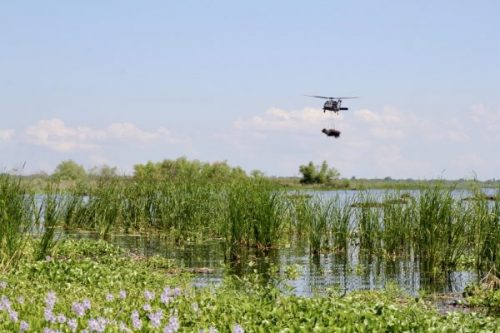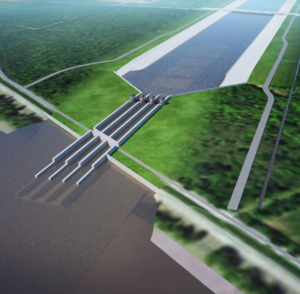Building a More Resilient New Orleans
Katie Donahue – City of NOLA, Office of Resilience and Sustainability
With Ida recovery ongoing, we are all intensely aware that New Orleans has a lot on the line when it comes to restoring coastlines and protecting communities from land loss and climate change impacts. They city’s very existence is at stake. Strategic, collaborative, and innovative solutions are essential to our continued progress.
In 2018, Tulane University and the National Wildlife Federation released recommendations for the City of New Orleans’ coastal resilience work, resulting in a published framework for action, Connecting Our City and Coast. The recommendations outlined in this plan originated from an intensive planning session with key business and industry leaders, state and local government officials, academia, NGOs, and community leaders. They center on three coastal resilience themes: coordinating with regional partners, communicating the need for action, and promoting equitable solutions. Those recommendations continue to shape our coastal resilience efforts today.

2021 Annual Christmas Tree Drop
Despite the challenges presented by the COVID-19 pandemic and storm impacts, we are encouraged by continued progress on urgent coastal issues and the engagement we’ve seen at all levels, starting with our residents. This past May, the City of New Orleans, along with state and federal partners including the Louisiana National Guard and the U.S. Fish and Wildlife Service, successfully conducted the annual Christmas Tree Drop. There was a 37% increase in recycled Christmas trees in 2021 – the City’s Department of Sanitation filled 59 trucks full of trees. This program would not be possible without the enthusiastic participation of residents looking to divert their Christmas trees from landfills and put them to good use protecting our marshes and shorelines.
We’ve also seen success in securing funding for and implementing large-scale coastal restoration projects that protect and restore our coast. The City of New Orleans received a $500,000 grant from the National Fish and Wildlife Foundation’s National Coastal Resilience Fund for the New Orleans East Landbridge project, which seeks to create a living shoreline and marshes on the Landbridge, a critical natural feature in the Coastal Master Plan that protects the City of New Orleans from storm surge in the Gulf.
Another exciting large-scale development came this past May, with the news that Governor John Bel Edwards had selected the Golden Triangle marsh restoration project, located east of New Orleans, to receive funding from the Deepwater Horizon oil spill. This project will create and nourish over 700 acres of marsh habitat, thus reducing storm surge, increasing flood protection, and restoring estuarine habitat in Orleans and St. Bernard parishes. Our wetlands act as our first line of defense against dangerous storm surge, and restoring this area is critical to help support our existing hurricane protection and levee system.
We are fortunate to have the support of the state and federal governments, not to mention our regional and parish-level partners, when it comes to matters of coastal restoration, an issue that highlights the importance of leadership as we move forward at this pivotal moment for the coast. The City of New Orleans is proud to support the proposed Mid-Barataria Sediment Diversion and submitted a public comment this past spring emphasizing the importance of this project for the future of our coast. We know we cannot afford a future without action. Sediment diversion projects are the cornerstone of CPRA’s Master Plan and represent a commitment to future Louisianans, demonstrating that we’re doing everything in our power to ensure they inherit a sustainable coast.

Conceptual design of Mid-Barataria Sediment Diversion Credit: The Water Institute of the Gulf
Here in New Orleans, we know the importance of nature-based solutions when it comes to living with water. We know we can build a more sustainable future by innovating and adapting. As Mayor Cantrell said in her op-ed in support of the project: “Our delta city was built by the sand and mud of the Mississippi River. Though we’ve walled it off, the river is intricately linked to our geography, culture, and economy. The river will continue to be critical, especially to the sustainability of the coast that protects our city. In part, because we’ve walled off the river and its natural land-building process, we are losing our coast at a rate of one football field of wetlands every 100 minutes. This is not just an issue for our neighboring parishes; this is a dire issue for every parish in the region.”
While we’re proud to report the progress we’ve made since the Connecting Our City and Coast convening, we know there’s still urgent work to be done. Our coastal priorities are all contingent on the fact that we cannot do this alone, that we are part of the broader system – inside and outside of the levees. We will continue to prioritize cross-departmental and regional coordination, effective communication, and the promotion of equitable solutions to one of the most existential issues facing our city and state.
To find out more about the City of New Orleans’ resilience work, please visit https://nola.gov/resilience/.
